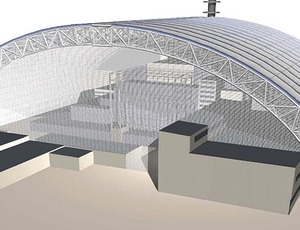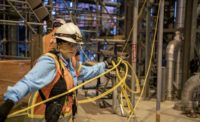

Twenty-eight years after devastating explosions and fire partially destroyed Ukraine's Chernobyl nuclear plant, the first half of a vast safe confinement has been completed. As work continues on the 25,000-tonne steelwork vault—tall enough to cover the Statue of Liberty—the parties to the cleanup are about to agree to a new construction price of around $2 billion, some 40% above the 2010 price.
The "complexities, quantities and unit costs have all been significantly under- estimated," says Vince Novak, director of nuclear safety at the European Bank for Reconstruction and Development (EBRD), the purse holder for the more than 40 governments funding the work.
Final commissioning of the 108- meter-tall, 162-m-long, 257-m-wide vault is running some three years behind the schedule set in 2010, adding to the costs. "It has certainly taken longer to complete the design stage than we anticipated [because of] the complexity and uniqueness of both the design effort and the review effort," says Novak.
The structurally complete vault's first half was slid toward the reactor building in April, making way for assembly of the second half of the structure.
Since Chernobyl's No. 4 reactor exploded in April 1986 in the world's worst nuclear accident to date, its highly radioactive remnants have remained within the patched-together steel-and-concrete enclosure, the hastily built "sarcophagus."
After the disaster, thousands of workers resealed and partially stabilized the ruined building under extremely hazardous conditions. Many of them died immediately as a result or had their lives shortened by radiation-linked illnesses.
In 2008, workers reinforced the sarcophagus under an internationally funded program of work. The largest project element is the new confinement to shelter the reactor building and contain radiation and contaminated materials, while less stable parts of the sarcophagus are removed amid long-term waste management operations.
Novarka, an equal joint venture of VINCI Construction Grands Projets and Bouygues Travaux Publics, both Paris, is building the confinement in two halves at a relatively safe 300 m away from the highly radioactive reactor building.
When joined together and fully equipped, the two halves will form a 31,000-tonne enclosure with a 100-year design life. It will be slid over the sarcophagus, which is still emitting high levels of radiation. The confinement is designed to minimize the need for workers to carry out maintenance operations nearby. For example, the arch-steelwork envelope is designed to keep humidity below 40%, eliminating corrosion and reducing the need for painting. Some 86,000 sq m of durable stainless-steel cladding will cover the arch.
By the time Novarka signed its design-build contract in late 2007, extensive conceptual designs for the cover had been completed by the plant owner's project management unit, a joint venture of Bechtel, San Francisco; Battelle Memorial Institute, Columbus, Ohio; and Electricité de France, Paris.
As Novarka mobilized on-site, engineers fleshed out the details so that, in 2010, a construction price of about $1.4 billion was agreed upon, including substantial estimates for designs yet to be completed. Three years later, these approximate "provisional sums" were seen as "seriously underestimated," says Novak.
Now, he says, "most of the risks have either been eliminated or significantly diminished." Negotiations have produced a new lump price, which EBRD will have independently audited, seeking agreement on the final terms within the next two months, he adds. Novarka officials declined to discuss the project.





Post a comment to this article
Report Abusive Comment